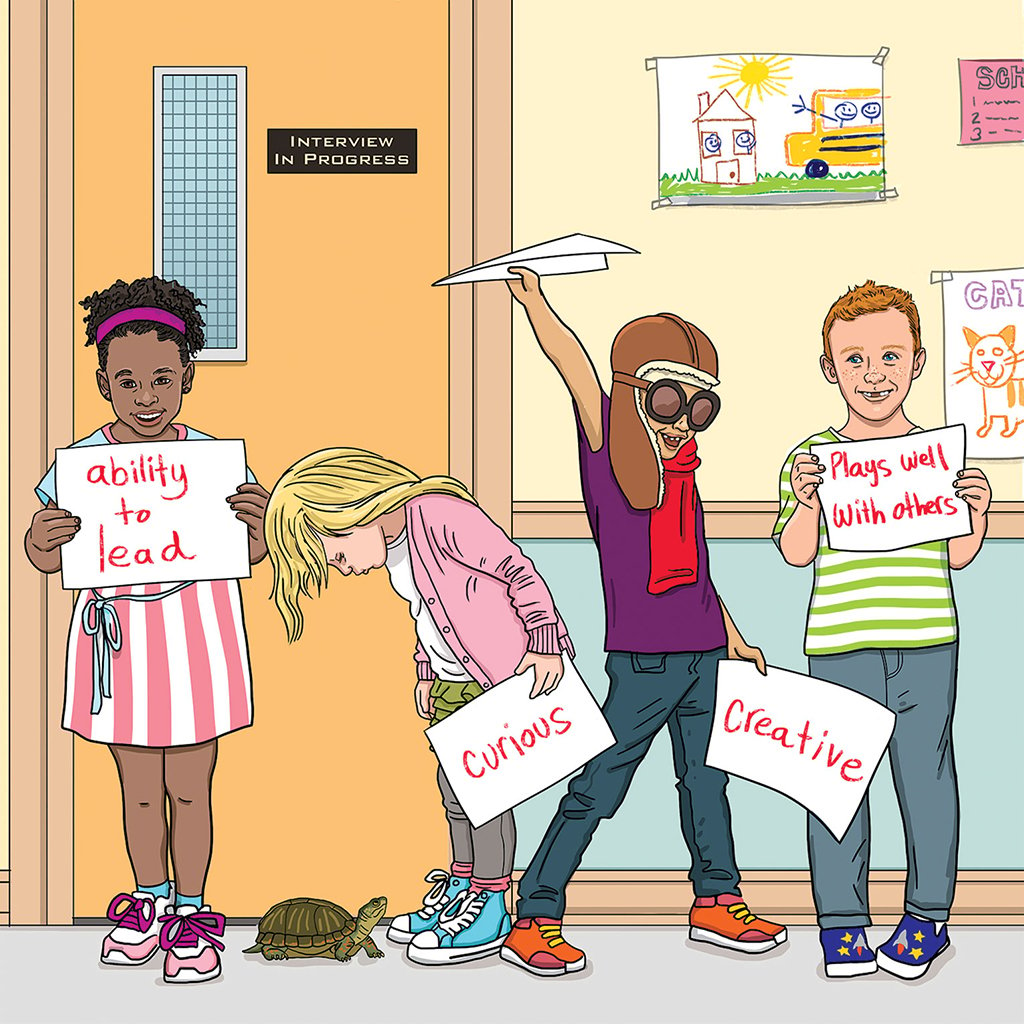It’s an eternal challenge in education: There are more potential students than there are spaces at a school. If you’re running a college, the solution is fairly simple—use some combination of SAT scores, high-school grades, essays, and interviews. But what if you’re running a preschool?
Public preschools don’t usually need to grapple with this problem. Every three-year-old can enroll. Private schools, especially those that market themselves based on small class sizes, have never had that luxury. So they’re left with some combination of testing, observing, getting to know the parents, and dumb luck.
But exactly what they test and observe for has changed. While schools have always looked at basic measures of development—can a three-year-old recognize colors or count?—admissions officers at local private schools say there’s a new focus on something that once seemed an afterthought: character.
Take one part of the typical application process—a teacher recommendation form, created by the Association of Independent Schools of Greater Washington (AISGW), which most area private schools require.
The form for admission into pre-K and kindergarten includes 35 rankings for abilities such as listening skills, cooperation, and curiosity. Additional questions ask about things that frustrate the child and about personality traits, including self-control and sense of humor. (Although a preschooler, by definition, won’t have had a previous teacher to fill out the form, it can be completed by a babysitter, camp leader, or daycare provider.)
The evaluation—which has been in use about ten years—is, according to AISGW’s Lynn Maloney, noticeably different when compared with the form used by independent schools in other parts of the country. An example is the “academic skills” section of the evaluation form used by San Francisco schools. It asks teachers about such skills as the ability to grip a pencil, draw with detail, and speak clearly. In their academic-skills section, by contrast, Washington-area schools want to know if a child is attentive, contributes to group discussions, and follows directions.
It’s all part of the “character movement,” says Meghan Brenneman, a researcher with the Enrollment Management Association, which develops admissions materials for private schools nationally. While preschools still care about a child’s skills—say, whether she can recognize letters—they’re also interested in such measures as ability to lead.
Schools have always tried to ensure that a child is a “good fit” with their culture, to create a cohesive cohort among students—who may be in the same classes for years. The attention to character is just another measure toward that goal. And the soon-to-be-longer teacher evaluation isn’t the only tool being tweaked to try to assess character.
Is Such Testing Reliable?
Many Washington independent schools use the Wechsler Pre-School and Primary Scale of Intelligence test (WPPSI) to evaluate young children. The 35-to-40-minute test uses pictures and symbols to measure information retention, processing and organization, and verbal comprehension.
But the WPPSI doesn’t look at creativity, individuality, and judgment, which some argue are increasingly important in 21st-century education. In response to requests from schools, Enrollment Management has developed the Character Skills Snapshot test, set to be launched at the end of September. Unlike the WPPSI, it measures such things as resilience, initiative, and intellectual curiosity.
For now, Snapshot is designed for older children, but early-elementary schools are already paying attention. “Research is coming out that says these non-cognitive skills can have a huge impact on success later in life—so we need that other piece in the puzzle” to make a decision, says Margie Gottfried, admissions director at Sheridan School in Northwest DC. Currently, Sheridan uses the WPPSI test.
Some question this kind of vetting for very young children. “At ages two, three, and four, kids are developmentally still all over the map,” says education psychologist David Palmer. “Early testing may not be reliable.”
Palmer doesn’t hold much faith in the subjective character-testing movement: “It’s very hard to design a test to evaluate character traits. The only effective way is to observe the child over time.” If selecting for personality is an attempt to weed out potential “problem” children (the schools we spoke to wouldn’t say if that’s one reason), he believes that can undermine schools and students. “Often, the brightest are not necessarily what’s considered the best student,” says Palmer, who explains that the smart students may be overactive or less cooperative simply because they’re bored.
Although schools are increasing their testing for personality, that doesn’t mean the goal is for all children to fit one mold. Schools say they’re still looking for diversity, not just a balance of race, gender, and socioeconomic background. “You don’t want a whole class of extroverts,” says Gottfried.
“We don’t want all the kids to be cookie-cutter,” agrees Ayesha Flaherty, head of enrollment management and communications at the Langley School in McLean. “Family structures are different; diversity is different than it was ten years ago. We’re getting smarter about that, more transparent, in part because demographics change and we live in a diverse area.”
While that may be true, the more thorough vetting of young kids reflects a more sophisticated knowledge about learning disabilities and other challenges, according to education consultant Clare Anderson: “We’re so much more aware of developmental blips, and schools have put safety supports in place in a much more strategic way.” Indeed, many private schools don’t have the resources to deal with disabilities, while some, such as the Lab School in DC, are specifically designed for such students. If a child appears to have a learning or behavior disability, schools will often suggest other options. “Schools have to be careful about who they can and cannot serve,” says Anderson.
Plays Well With Others
Another hurdle that schools are taking more seriously is the student interview. While some engage with children one-on-one, others invite a group of about five for some play and story time, also without the parents. This provides an opportunity to see how kids cooperate (or not) as well as insights into personalities and learning styles. Although for years schools have had some version of a student interview, what they’re looking for has changed.
“Over the last five years, we’ve added the creative element that we didn’t have before,” says Sheridan School’s Gottfried. “We’re looking for highly verbal, creative problem-solvers. So we’ll read a story to the child, and after one page we ask what will happen next. It doesn’t have to be spot-on, but it shows problem-solving and creativity.”
The children then are shown three pictures and asked to tell a story based on them. “Some are very literal, just describing the pictures, but there are some children who create amazing stories,” says Gottfried.
This one-time look doesn’t always give a complete or accurate picture, though. The kids might be tired or anxious. That’s why, if parents are really concerned that an interview didn’t go well, some admissions directors will go see a child in her preschool or daycare. It’s also why Gottfried often interviews the parents after observing the child, so they can discuss how the behavior might differ with a change of setting.
In other words, a bad interview isn’t a deal-breaker. It wasn’t for Virginia Jones’s three-year-old daughter, who, during an interview at a Montessori school in Arlington, “immediately crawled under a table and wouldn’t come out.”
“She had a lot of separation anxiety, so it was stressful,” says Jones, a family psychologist, adding that although she found the experience stressful herself, she did it because she thought the school would be a good fit. And it is—her child got in.
“I think parents are uncomfortable with the process,” Jones says, “but because of the rat race we live in, we have to live with it.”
Is Honesty the Best Policy?
Parents might think they’re eyeballing a school during the interview process, but the school is eyeballing right back. Some of the things admissions officers look for may be eternal—how involved parents may be or how thick their checkbook—but others directly complement the new thinking about character.
Anderson stresses that candor is essential in the parent interview, which more schools refer to as an open house or simply a meeting. That frank discussion will include the child’s highs and lows. Schools can be skeptical if the child is portrayed as flawless. “The perfect package can be the kiss of death,” says Anderson.
But parents are skeptical that honesty is the best policy. Does that mean you should admit that Junior can be a bully? No, says Anderson: “Just give examples of who your child is in different areas—school, home, playground. No judgments, just specific behaviors.” She advises getting that story straight before the meeting. “Parents aren’t going to agree on everything.”
There Are Alternatives
The admissions process may differ for schools with a particular focus or culture. Alexandria’s River Farm Cooperative K-6, founded in 2013, has a nature-oriented curriculum in which its two dozen students spend a significant portion of the day outdoors and go on field trips once or twice a month. The cooperative model keeps tuition relatively low—in this case, $5,652 for all grades—by requiring parents to volunteer about five hours a week in the classroom or with fundraising, maintenance, and website work. River Farm’s application is predictably interested in the subjects of parental involvement, experience, and skills. The school also checks how much the kids enjoy being outdoors.
Etaine Raphael enrolled her two daughters, ages five and seven, at River Farm after some unhappy experiences in public and Catholic schools. The older girl was the first to go in for the student interview last December. River Farm’s interviews mean a daylong immersion session without the parents.
“It was pouring rain, and that day’s activity was to go for a hike,” says Raphael, a physical therapist. “At the end, she came to the car soaking wet but had the best day ever.”
Raphael liked that River Farm doesn’t require cognitive testing: “Research shows that testing doesn’t mean much at that age, and I’m a little queasy about schools that require it, because why would you do that if you’d looked at the research?”
The Waiting Game
The search for a “good fit” affects the way that schools’ sometimes long waiting lists work. Schools call them “wait pools” because they don’t list applicants on a first-come-first-served basis. Instead, they pool them according to personality, learning style, and other qualitative measures.
“Where’s my kid on the list?” is a question Liz Yee hears a lot as admissions director at the Lowell School in Northwest DC. “We have to explain that we look at the cohort—the socioeconomic, racial, and gender balance.”
Despite the extra work on both ends, most admissions officers, consultants, and even some parents we spoke with think the more assessment tools, the better. A broader evaluation can counter potential biases from, say, one teacher’s recommendation or one tester’s report.
“We don’t want to make this hard,” says AISGW’S Maloney. “We don’t want to create a lot of hoops.”
It probably doesn’t hurt that it also makes the admissions process so exclusive that some parents may be convinced that the institutions merit their elite status—and their high prices.
This article appears in the October 2017 issue of Washingtonian.


















